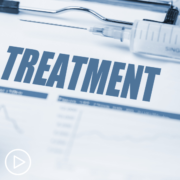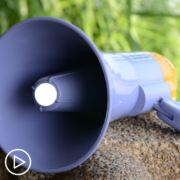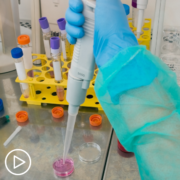Follicular Lymphoma: What Treatment Options Are Available?
Follicular Lymphoma: What Treatment Options Are Available? from Patient Empowerment Network on Vimeo.
Dr. Tycel Phillips provides an overview of follicular lymphoma treatments available to newly diagnosed patients and reviews the pros and cons of oral regimens and stem cell transplant.
Dr. Tycel Jovelle Phillips is a Medical Oncologist in the Hematology Clinic at The University of Michigan Rogel Cancer Center. Learn more about Dr. Phillips, here.
See More from The Pro-Active Follicular Lymphoma Patient Toolkit
Related Programs:

What Factors Are Considered When Choosing a Follicular Lymphoma Treatment? |

|

Why Follicular Lymphoma Patients Should Speak Up About Symptoms and Side Effects |
Transcript:
Katherine:
Now that we’ve discussed factors that can impact treatment decisions, would you walk us through the currently available follicular lymphoma treatment approaches? And who they might be right for?
Dr. Phillips:
Sure. So, we’ll start with the newly diagnosed or untreated patient. So, again, if you’re newly diagnosed or untreated, your options are the monoclonal antibody, Rituximab. Again, that’s a CD20 monoclonal antibody.
That is typically given once weekly for four weeks and can be repeated, if need be, after a break. And that’s usually reserved for patients who have minimal symptoms, low burden disease. Because, again, data has shown that the bulkier the disease, you’re likely not to have a very durable or deep response with just simulating Rituximab. Additional options include Rituximab plus chemotherapy.
So, we have regimens such as CDP, which is Cytoxan, vincristine, and prednisone. Cytoxan and vincristine being a steroid, prednisone being — sorry, Cytoxan and vincristine being a chemotherapy agent, and prednisone being a steroid. We have our bendamustine, bendamustine being a chemotherapy agent. There’s R-CHOP, which is Cytoxan, vincristine, Adriamycin, and prednisone. And sometimes that is reserved, because unlike the other two, R-CHOP can only be given once because of the accumulation of the anthracycline.
You can only have so much of that in a lifetime before you run a risk of cardiac toxicity.
Katherine:
Oh.
Dr. Phillips:
And also, R-CHOP as of right now is a standard of care for diffuse large B-cell lymphoma. Which every patient with follicular lymphoma has a chance of transforming into diffuse large B-cell lymphoma at some point. So, we tend to try to reserve R-CHOP if we can. Additionally, more recently, there was a study called Relevance, which evaluated RPMO versus an agent called lenalidomide plus Rituximab, what we call R squared.
So, it was designed as a superiority study, but what came out of it is R squared is probably equivalent, not better, than R chemo. So that is also an option up front. With lenalidomide it’s a little bit different than the other agents, which all give it intravenously, meaning through the vein. But lenalidomide is an oral medication, that you would take 21 days on, and seven days off. And that’s given in conjunction with the Rituximab. And you typically would take that for 12 cycles, or about a year of treatment.
Whereas the chemotherapy regimens that I mentioned before, are typically given for six cycles. Meaning you’ll be taking it for a duration of 18 weeks or 24 weeks. So around four and half to six months for the chemotherapy. Thereafter, it’s a bit controversial, but some patients can then transition to what we call Rituximab maintenance.
Where you would get Rituximab every other month for a period of two to three years. Typically, two years, as a way to delay the return of the cancer. So, R maintenance we know of improves your progression of survival, so the time until the cancer comes back. And there is no survival benefit with maintenance at this point. So, it is in some ways a bit controversial. Especially now, given the pandemic.
Katherine:
What about stem cell transplant? Is that an option?
Dr. Phillips:
So, for up front, that’s usually not something that we typically do. So, for stem cell transplantation, there are two types of stem cell transplantation. There’s one called an Autologous Stem Cell Transplantation, which is basically really a stem cell rescue.
You get a high dose of chemotherapy after stem cells are collected from you and those stem cells are given back to rescue your body from the chemo. That is typically reserved for what we call high risk patients. So, we give you an initial up front chemotherapy regimen. And if your cancer comes back within less than 24 months of completion of that therapy, you fall into what we call a POD24 category. Which means Progression of Disease within 24 months.
We do know those patients are at higher risk, than patients who stay in remission for at least 24 months or longer. So, if we look at overall survival for those POD24 patients, about half of those patients will succumb to their disease within a five-year period. Which is much different for what we see with the standard for follicular lymphoma patients. So, and that POD24 category it does appear that Autologous Stem Cell Transplantation is beneficial in that patient population. As well as an Allogenic Stem Cell Transplant. So, an allogenic transplant is when you get immune cells from another donor.
So, “allo” meaning from a different person. So, in that sense, you get sort of temporized, and they would give you donor lymphocytes. And those lymphocytes themselves would try to fight off your cancer. So, an Auto transplant is mainly just chemo; an Allo transplant, the donor cells help fight off the cancer.
Katherine:
Right.
Dr. Phillips:
There are complications to both, which is why they’re not typically given up front. The Allo transplant probably has more risk of complications as well. Those cells can also recognize your body as being foreign and try to fight them off because they don’t originate from you. And there’s also just a risk of other death from that procedure. So, all those have to be taken with a bit of caution. And for the Allo transplant, it’s generally only recommended if you have that, a sibling donor. Because there’s much less risk of complications than versus you get an unrelated donor.










